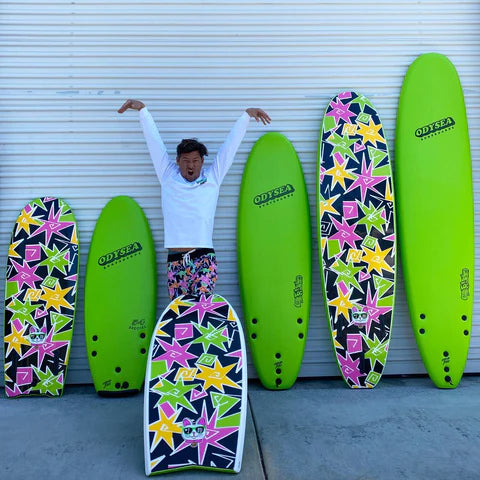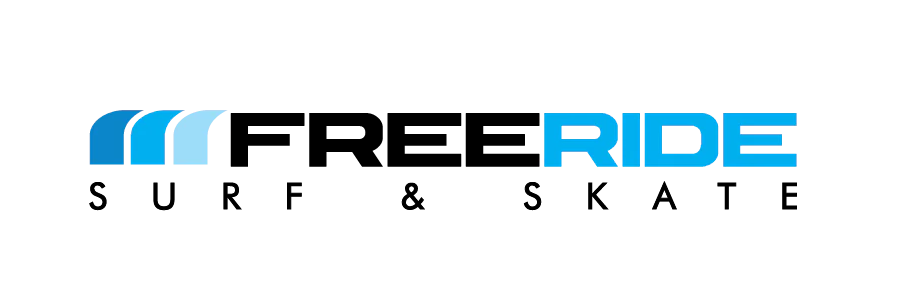
News
Surfboard Types - and How To Choose the Right One for you
Surfboard Types - and How To Choose the Right One for you
We know you’re keen to get out on the waves. But without being a killjoy, we’re here to tell you that there’s so much more to buying a surfboard than just choosing one that looks cool.
Surfing is a technical sport - and one that’s famously hard to grasp - and finding the right surfboard could make or break your progression out there. If you’re just learning to surf, for example, you’ll need a different board to those you see pros doing their thing on.
The right board boils down to your current skill level, your fitness level and the surf conditions you’ll be riding in. Luckily, here at Freeride, we know the ins and outs of surfboard types. We’ve put together a guide to help you narrow in on your new best friend, so surfing can be even more enjoyable.
Get started with softboards
If you’re still a newbie to surfing, start soft with a softboard from brands like Catch, Platino and Stormblade.

The safe and easy-to-paddle option that’s perfect to get started with, softboards provide stability while you find your feet. We can thank this surfboard’s large volume and buoyancy that helps both beginners and children to balance and paddle, and eventually catch a wave. A foam surfboard reduces your chance of injury, too, which can help with confidence.
Entry level fibreglass boards
When it comes to entry level fibreglass boards, we love Modern Surfboards, Hot Buttered and Modom Surfboards.
Once you’ve mastered paddling and standing up on a softboard, your natural progression will be to move onto a fibreglass hard board - a board that’s been popular in New Zealand and across the world for more than 50 years.
Not sure which one to switch to? Your ideal board’s length and volume depends on factors like your weight, and the paddling balance and natural strength you’ve built up in your first few surfing experiences. As a general rule of thumb, a longer board delivers more volume and stability, making it easier to catch those waves.
If you’re under 60kgs, try out a 6’0 to 6’4 Fish or Small Mini Mal of 6’10 to 7’6. The retro-style Fish surfboard is quick by nature and helps the intermediate surfer to up their speed, while a Mini Mal is a mid-length board that can provide a more comfortable and forgiving surface than longboards.
Performance fibreglass boards
As you move up a level, a performance fibreglass board could be just what you’re looking for. Look out for brands like Pyzel, DHD, Christenson, Cabianca, LSD, Mark Richards and Chilli. They’re what we like to call “the Porsche of surfboard design” and are both a visual and technical treat, in modern designs and models that are constantly updated.
There’s no “one size fits all” here and each design is specifically targeted at different wave sizes.
Check out this quick guide to the best board for wave size:
- Small waves (1ft - 4ft) - Hybrids & Fishes
- Good waves (2ft - 5ft) - Daily Drivers
- Solid ocean waves (6ft +) - Step Ups
- For cruisey surfing (1ft - 5ft waves) - Mid-lengths and longboards (these are modern versions of traditional board designs)
These fibreglass boards are available in different setups, depending on the intricacy of the design. They are:
- 3-fin (Thruster)
- 4-fin (Quad)
- Twin Fin
- Single Fin
 Longboards made for small waves & beginner surfers
Longboards made for small waves & beginner surfers
Taking on smaller waves of 1 foot - 4 foot? Longboards are a throwback to the 60’s and 70’s that have drummed up popularity amongst today’s younger surfers looking to inject some of that 60’s vibe into their surfing lifestyle.
You’ll find longboards from brands like Hot Buttered are perfect for beginners.
Before you buy a longboard, it’s best to read up on the best size for you and the waves you’ll be catching. Finding the right one takes your longboard from nostalgic hipster to pro surfer.
Traditional longboards
Ranging in size from 9’2 to 9’6, traditional longboards are a great option for entry-level surfers and those with a bigger frame. They make it easier to paddle as well as catch waves, especially in a smaller and weaker surf.
That’s because these longboards have more weight, so can carry more momentum through flat sections, while providing that bit more stability when surfing from the nose.
High-performance longboards
The high-performance longboard is designed to surf like a shortboard. They have an overall lighter weight for their size, and can be surfed aggressively, thanks to a fin configuration that gears the board toward performance surfing.
The length gives the surfer more control than a shortboard might, and you’ll enjoy more hold on those steeper waves.
Soft top longboards
For the less experienced surfer, playing it safe with a soft top may be the way to go. Easy to paddle, and providing more stability and less risk of injury, you’ll have an easier job of keeping up with your more advanced surfer mates!
If you’re a beginner, an 8ft - 9ft foam longboard could be a great option.
The importance of surfboard volume
You might have a better idea of surfboard types, but we’re not done yet! The volume of a surfboard plays a crucial role in whether it’s right for you, because you’ll be taking into account things like your height, weight and fitness level.
Without getting too mathematical, the volume of a surfboard describes its area in litres. This is calculated by using length x width x height. Getting the right volume impacts your entire surfing experience. It can affect everything from paddle power to stability, control, speed, performance and much more.
You might have also heard of low volume and high volume surfboards. A low volume board has a lower volume than the recommended for your height and weight, and should be reserved for the experienced surfer only. This offers a more sensitive experience and can provide greater control for skilled surfers, but less speed and more drag for amateur surfers. A low volume board can be fun to ride small to medium sized waves.
A high volume surfboard - you guessed it - has a higher volume than what is suggested for you. They provide great weight support and are a good option for those just learning to surf. Of course, that makes them unsuitable for advanced surfers or those competing since it also means less control and maneuverability.
Need a helping hand? Take your skills to the next level with the right surfboard. LIVE CHAT us direct from the web site and our team will help you find that perfect surfboard. Otherwise, visit us at The Boundary, 5 Vitasovich Ave, Waitakere, Henderson, Auckland.
